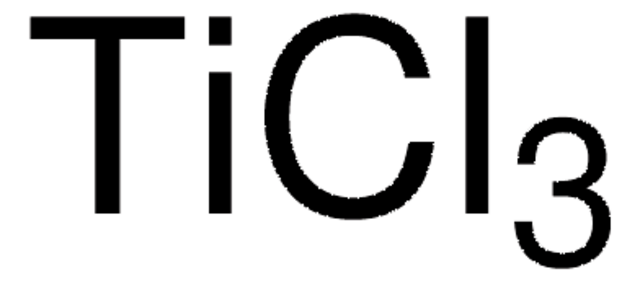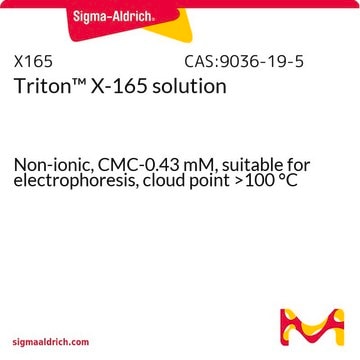249998
Titanium(III) chloride solution
~10 wt. % in 20-30 wt. % hydrochloric acid
Synonym(s):
Titanium trichloride
Sign Into View Organizational & Contract Pricing
All Photos(1)
About This Item
Linear Formula:
TiCl3
CAS Number:
Molecular Weight:
154.23
MDL number:
UNSPSC Code:
12352301
PubChem Substance ID:
Recommended Products
reaction suitability
reagent type: catalyst
core: titanium
concentration
~10 wt. % in 20-30 wt. % hydrochloric acid
density
1.192 g/mL at 25 °C
SMILES string
Cl[Ti](Cl)Cl
InChI
1S/3ClH.Ti/h3*1H;/q;;;+3/p-3
InChI key
YONPGGFAJWQGJC-UHFFFAOYSA-K
Looking for similar products? Visit Product Comparison Guide
Application
Catalyst for:
Hydrogen desorption properties
Nitrogen-nitrogen reductive bond cleavage
Reagent for:
Photocatalyst synthesis
Preparation of nanostructures titania/cetyltrimethyammonium bromide nanoskeleton
Hydrogen desorption properties
Nitrogen-nitrogen reductive bond cleavage
Reagent for:
Photocatalyst synthesis
Preparation of nanostructures titania/cetyltrimethyammonium bromide nanoskeleton
Other Notes
Exact concentration stated on label
Signal Word
Danger
Hazard Statements
Precautionary Statements
Hazard Classifications
Eye Dam. 1 - Met. Corr. 1 - Skin Corr. 1B - STOT SE 3
Target Organs
Respiratory system
Storage Class Code
8B - Non-combustible corrosive hazardous materials
WGK
WGK 3
Flash Point(F)
Not applicable
Flash Point(C)
Not applicable
Personal Protective Equipment
dust mask type N95 (US), Eyeshields, Gloves
Choose from one of the most recent versions:
Already Own This Product?
Find documentation for the products that you have recently purchased in the Document Library.
S. Isobe, et al.,
Applied Physics Letters, 99 (2011)
Shuxi Dai et al.
Nanoscale research letters, 5(11), 1829-1835 (2010-12-03)
Highly crystalline TiO(2) nanostructures were prepared through a facile inorganic acid-assisted hydrothermal treatment of hexagonal-structured assemblies of nanocrystalline titiania templated by cetyltrimethylammonium bromide (Hex-ncTiO(2)/CTAB Nanoskeleton) as starting materials. All samples were characterized by X-ray diffraction (XRD) and transmission electron microscopy
D. Meroni, et al
Catalysis Today, 161, 169-174 (2011)
Catalytic oxidation of hydrazo derivatives promoted by a TiCl3/HBr system.
Eyal Drug et al.
Journal of the American Chemical Society, 129(45), 13784-13785 (2007-10-26)
C Noubactep et al.
Journal of hazardous materials, 132(2-3), 202-212 (2005-11-08)
The effectiveness of elemental iron (Fe(0)) to remove uranium (U) from the aqueous phase has been demonstrated. While the mitigation effect is sure, discrepancies in the removal mechanism have been reported. The objective of this study was to investigate the
Our team of scientists has experience in all areas of research including Life Science, Material Science, Chemical Synthesis, Chromatography, Analytical and many others.
Contact Technical Service









